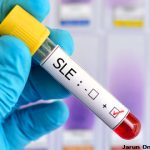 Childhood-onset systemic lupus erythematosus (SLE) differs from adult-onset SLE in many ways, including increased severity and abruptness of onset. Researchers from the School of Medical Science at the University of Campinas, Brazil, and the Judith & Stuart Colton Center for Autoimmunity at the New York University School of Medicine examined if these differences in presentation translated into a different genetic basis for the disease.
Childhood-onset systemic lupus erythematosus (SLE) differs from adult-onset SLE in many ways, including increased severity and abruptness of onset. Researchers from the School of Medical Science at the University of Campinas, Brazil, and the Judith & Stuart Colton Center for Autoimmunity at the New York University School of Medicine examined if these differences in presentation translated into a different genetic basis for the disease.
“The University of Campinas has a unique resource readily available to answer this question about genetics and inheritance in lupus,” says Timothy Niewold, MD, Judith & Stuart Colton Professor of Medicine and Pathology at New York University. “They have detailed family histories on large family structures [because] it is not uncommon to have six or more children [in Brazilian families]. If you are studying the inheritance of a rare condition, such as lupus, it helps to have many children per family.”
3 Generations Studied
The researchers looked at 392 consecutive SLE patients (112 childhood-onset and 280 adult-onset) seen at the Pediatric and Adult Outpatient Clinic of University of Campinas from January 2016 to December 2018. After confirming the patient fulfilled at least four of the ACR criteria for SLE, they were personally interviewed. Data on familial history were collected across three generations for each patient, and extended familial pedigrees were constructed.
Three hundred and ninety-two individuals were assessed. Researchers identified 2,574 first-degree relatives, 5,490 second-degree relatives and 6,805 third-degree relatives. If a patient’s first symptoms attributed to SLE occurred at or before the age of 18, they were defined as having childhood-onset SLE. Those diagnosed after 18 were placed in the adult-onset SLE group.
Medical histories, as well as the clinical and serological characteristics of the patients, were collected at diagnosis and follow-up. Researchers compared the presence of cumulative clinical manifestations, laboratory results and immunological features between single- and multiple-case SLE families. Disease activity was measured using the SLE Disease Activity Index (SLEDAI) at each visit, and adjusted scores were calculated over time. Cumulative disease-related damage in all patients was determined using the SLE International Collaborating Clinics/ACR Damage Index.
The relative recurrence rate of SLE was calculated for each degree of relation to the SLE patient.
Predicting Inheritance Patterns
“We used mathematical models to predict inheritance patterns; the subjects were not directly genotyped,” says Dr. Niewold. “We found childhood-onset disease was characterized by a larger number of risk factors, as predicted by the models.”
In the overall cohort, researchers noted a familial recurrence rate of 19.4 in first-degree relatives. This rate was 5.4 in second-degree family and 3.0 in third-degree relatives. When they looked at childhood- vs. adult-onset SLE, rates were higher in first- and second-degree relatives of adult-onset SLE patients (25.2 vs. 18.4 in first-degree relatives and 8.5 vs. 4.5 in second-degree relatives). However, third-degree relatives showed a higher rate of adult-onset SLE (P=2.2×10-4 for differences in recurrence proportions between childhood- and adult-onset SLE).
“The pattern for childhood-onset SLE is that there are a large number of risk factors in general and a more polygenic cause of the disease,” says Dr. Niewold. “In adult-onset SLE, the pattern that fits best was that of a single strong risk factor and other more moderate risk factors that were less polygenic and epistatic, meaning there is less evidence for interaction between genes.”
No Phenotype Differences Found
Researchers found no phenotype differences between patients from multi-case SLE families when compared with families with a single-case of SLE for disease onset, duration, cumulative SLEDAI scores, last visit ACR Damage Index or number of ACR criteria. Although some reports have suggested SLE families have fewer male children, researchers in this study found no evidence of sex skewing in the offspring of SLE patients.
“We had wondered if the reason a younger person gets SLE is because they have a stronger set of risk factors, and I think this study bears that out,” says Dr. Niewold.
Understanding Genotyping Differences
The next step is to conduct genotyping to gain a better understanding of the differences between childhood- and adult-onset SLE. The authors conclude that their findings suggest “adult‐onset SLE may be characterized by fewer risk factors that are individually stronger” and that childhood-onset SLE involves “a higher genetic load.” If confirmed, this concept may lead to new ways to treat the different presentations of SLE.
The Genetic Load of Lupus
According to Tamar Rubinstein, MD, assistant professor of pediatric rheumatology at Children’s Hospital at Montefiore, Bronx, N.Y., this study is important in an effort to better define the genetic load associated with lupus.
“This is one of the few articles, to my knowledge, that has addressed differences in genetic susceptibility between adult-onset SLE and childhood-onset disease,” she says. “It makes sense that the genetic susceptibility will be different between the two, and not only because one presents earlier. This study adds to our knowledge by showing different patterns of inheritance with a higher genetic load in childhood-onset SLE.”
These findings may be difficult to translate into counseling for patients. No specific genetic analysis was conducted looking for the genes that lead to SLE susceptibility.
“This [study] doesn’t give us enough information to tell a patient in the clinic that their first-degree relatives should be tested to see if they are likely to develop lupus,” Dr. Rubinstein says. “What this paper, along with other research, hints at is that somewhere down the line we may be able to add genetic counseling to our toolbox. This paper by itself, isn’t going to change how we talk to our patients, but it does add to the evidence that there is a very complex genetic component involved.”
Kurt Ullman is a freelance writer based in Indiana.
Reference
- Sinicato NA, de Oliveira L, Lapa A, et al. Familial aggregation of childhood- and adulthood-onset systemic lupus erythematosus. Arthritis Care Res (Hoboken). 2020 Aug;72(8):1147–1151. Epub 2020 Jun 11.




